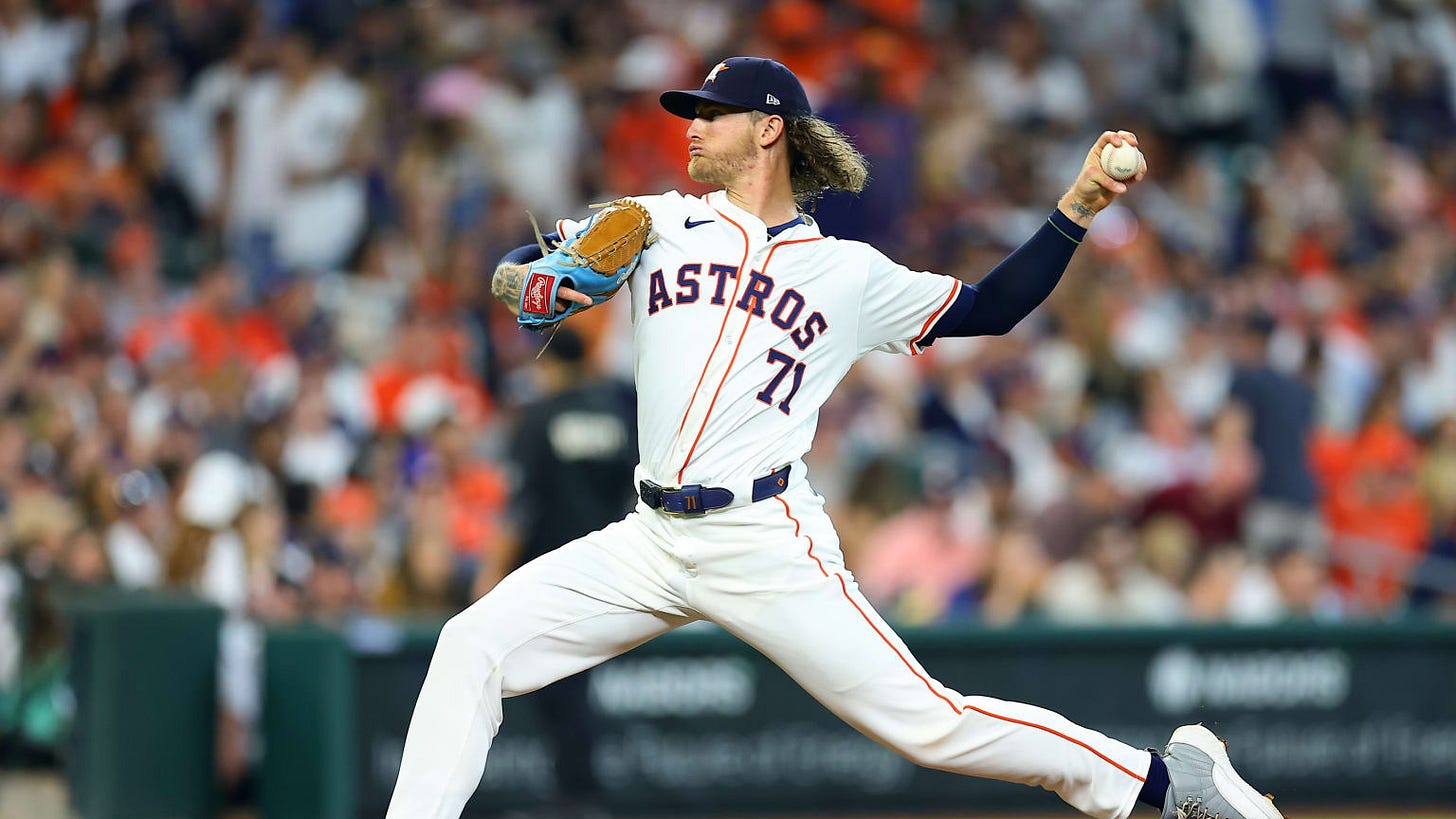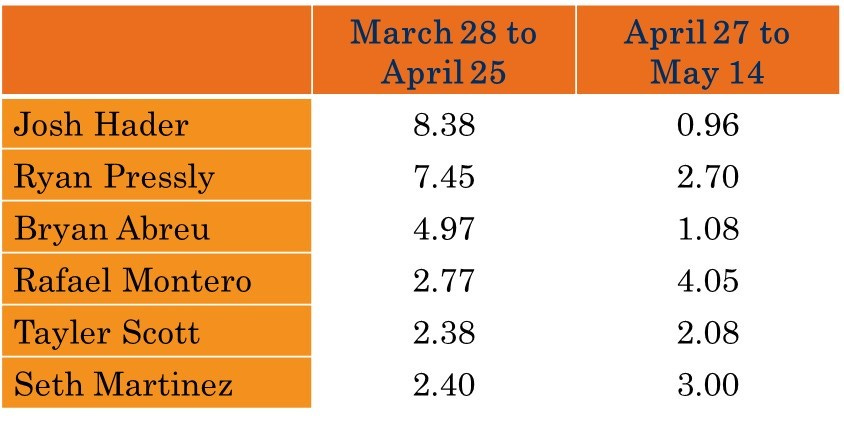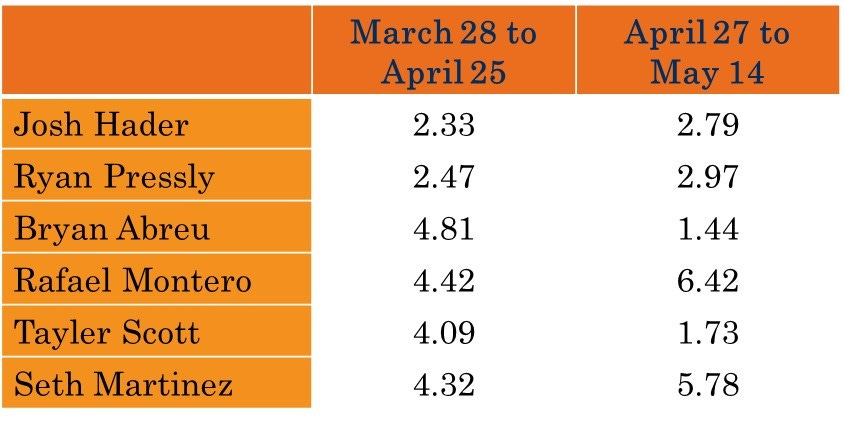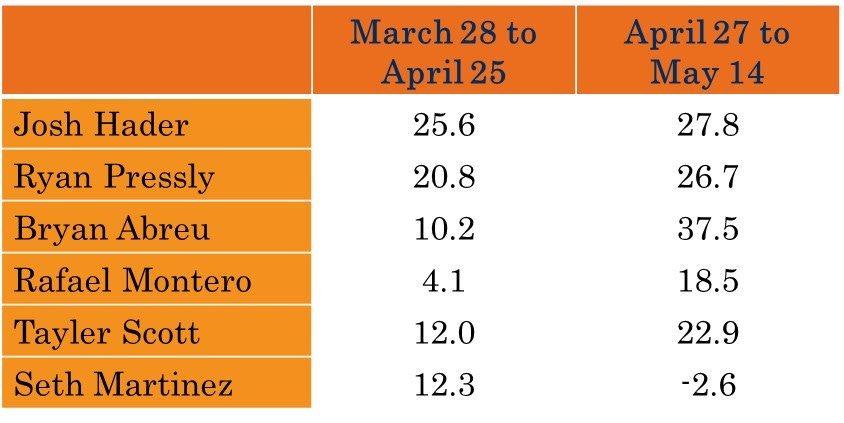The Bullpen's Turnaround Has Been Both Illusory and Important
The Astros bullpen pitched in bad luck in the first part of the season. The good news is they have turned it around. The bad news is the losses from that first part of the season still count.
It started poorly. Ryan Pressly took the loss on Opening Day; Tayler Scott in Game 2; Bryan Abreu in Game 3, and Josh Hader in Game 4 of the season. After avoiding the bullpen in the team’s first win (the Ronel Blanco no-hitter), Josh Hader had his first save opportunity in the season’s 6th game. He gave up a 2-run, 2 out homer to blow the game.
And it didn’t get much better for a while. Through the season’s first 26 games, the Astros bullpen had an ERA of 5.13 and had a record of 2-9. Fangraphs calculates that they were 0.3 wins below replacement value—which is to say that a bunch of scrubs called up from the PCL could do just as well.
A loss on April 25—credited to Rafael Montero capped off a sweep at Wrigley Field and put the Astros at 7-19 on the season. The Astros bullpen—and their season—was a disaster.
And then it got better.
After a day off on April 26, and whatever they did on that day was just what the needed. The Astros swept the mini-series in Mexico City against the Rockies and have won 13 of their last 19 games.
A big key to that turnaround is the bullpen. Over the 19 games, the Astros bullpen has turned in a 2.88 ERA, and have been credited with 4 wins and only 2 losses. They have also saved 6 games in that time. In short, it’s like a new bullpen.
And you can see that improvement in this chart, which shows the ERA for the six most used arms in the Astros bullpen before and after the Mexico City series.
For four of the six bullpen arms, one can see a decline in the ERA. In particular, the three-headed bullpen monster of Hader, Pressly, and Abreu have recovered from miserable starts to post the type of numbers we expected this offseason. Tayler Scott continued to pitch well. Seth Martinez’s ERA went up, but to 3.00. Only Rafael Montero had a significant increase in his ERA.
That’s an impressive improvement.
Except most of it was illusory.
This second chart shows these pitcher’s FIPs. FIP stands for Fielding Independent Pitching, and it rests of the assumption that pitchers can only control three types of plays—strikeouts (good); walks (bad); and home runs (terrible pitches). And based on this measure, you can see that neither Josh Hader nor Ryan Pressly improved after the Mexico City trip. Both were quite good both before and after the Rockies series.
Instead, Hader and Pressly were the victims of bad luck—balls were finding holes rather than gloves. One can measure this through BABIP—Batting Average of Balls in Play. The major league average for BABIP this year is .286. Before Mexico, Pressly had a BABIP of .448 and Hader’s was an astronomical .476.
The numbers also show you that Montero and Martinez have pitched better than they “should” have. And that’s for a similar reason. Montero and Martinez both have below average BABIPs—.189 and .224 respectively this season.
The improvement of Bryan Abreu is not illusory, as his FIP has gone from 4.81 to 1.44. Unsurprisingly, yis ERA has come down as a result. Tayler Scott had a good ERA in both periods I studied, but it was due to luck in the first part of the season (4.09 FIP) and skill in the second part (1.73 FIP).
You can see also see improvement from the bullpen in the chart below, which shows the strikeout rate minus walk rate for the two time periods. Basically, this shows what share plate appearances end with a strikeout instead of a walk. Higher rates are of course better.
And you can see that 5 of these 6 relievers improved. It’s a modest improvement for Tayler Scott and a clear one for Rafael Montero and (most importantly) Bryan Abreu. In fact, Abreu had struck out half of the batters he had seen from the start Rockies series to the end of the A’s series.
It’s basically a nominal improvement for Hader and Pressly. It shows they have not improved—they were always making good pitches; now the ones that are being hit are less likely to fall in for a hit.

The Bullpen Slump Wasn’t a Slump…Except in the Standings
The Astros bullpen wasn’t as bad as it seemed early in the season, especially its top arms in Hader and Pressly. Over the long run, water finds its level. That’s what happened with the Astros bullpen.
But the bullpen’s bad luck during the first part of the season is not guaranteed to even itself out over the rest of the season. Once a loss is banked, it’s banked. And just because a team had a tough luck loss does not mean they will dish out as many to their opponents.
The Astros began the season losing their first 7 one-run games. One-run games are essentially coin flips—they could go either way. Except they didn’t, and a big reason for that was the bad luck of the Astros bullpen.
The good news is that the Astros have recovered. With their 5-4 win last night, the Astros have now won 4 of the last 6 one-run games they have played. That makes them 4-9 over the course of the season in one-run games.
The Astros cannot make up those 9 losses now. Had the coin flip gone their way an average number of times, they would have 2 or 3 more wins on the season. Those would be really helpful right now with the Astros 4 games behind the Mariners in the AL West. They might be really helpful if the AL West or a Wild Card spot comes down to a game or two at the end of the season.
Unfortunately, the Astros bullpen cannot change the first stretch of the season. We can only hope they keep performing over the rest of the season like they have in the second stretch of the season.







Really good article. Provides a better understanding of what happened. A question though. I understand the rationale r regarding the three true outcomes and bapip. Still, it seems to me pitchers still play a role in whether balls are caught or not. A ball that is barrelled or hard hit is often more likely to be a bit rather than a lazy fly ball or weak grounder. Especially now with the limits on the shift. Do, would a comparison of the hard hit and barrel rates for these pitches change your perspective on the before and after of the bullpen? I'm sure I could do the research myself to see, but I'm also just curious about your thoughts about my general premise here.